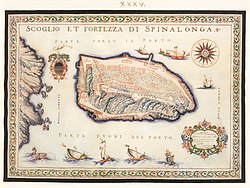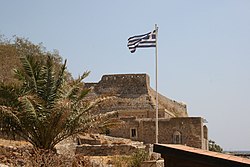Agios Nikolaos / Spinaloga
Agios Nikolaos, Hagios Nikolaos or Aghios Nikolaos (Greek: Άγιος Νικόλαος [ˈaʝoz niˈkolaos]) is a coastal town on the Greek island of Crete, lying east of the island's capital Heraklion, north of the town of Ierapetra and west of the town of Sitia.
In the year 2011, the Municipality of Agios Nikolaos, which takes in part of the surrounding villages, claimed 27,074 inhabitants. The town is a municipality of the Crete region and sits partially upon the ruins of the ancient city of Lato pros Kamara.
History
Agios Nikolaos was settled in the late Bronze Age by Dorian occupants of Lato, at a time when the security of the Lato hillfort became a lesser concern and easy access to the harbour at Agios Nikolaos became more important.[2]
The name Agios Nikolaos means Saint Nicholas. Its stress lies on the second syllable of the word "Nikolaos". Agios Nikolaos or Ayios Nikolaos (alternative romanizations of the Greek Άγιος Νικόλαος) is a common placename in Greece and Cyprus, since Saint Nicholas is the patron saint of sailors and of all of Greece.
Archaeology
Lato pros Kamara, the ancient Hagios Nikolaos, has left some limited ruins but an extensive cemetery of Roman times. 6 Near the town there's an archaeological site of ancient Priniatikos Pyrgos. It appears to have been first settled in the Final Neolithic era, circa 3000 BC. Activity on the site continued throughout the Minoan Bronze Age and the Classical Greek and Roman periods, spanning a total of up to 4,000 years. Since 2007, Priniatikos Pyrgos has been undergoing excavation by an international team under the auspices of the Irish Institute of Hellenic Studies at Athens.
Geography
Municipality
The municipality of Agios Nikolaos was formed at the 2011 local government reform by the merger of the following 3 former municipalities, which became municipal units:[3]
Agios Nikolaos
Neapoli
Vrachasi
The municipality has an area of 511.694 km2 (197.566 sq mi), the municipal unit 317.834 km2 (122.716 sq mi).[4]
Infrastructure
Culture
Modern Agios Nikolaos
Agios Nikolaos is probably best known as a tourist town that serves as a hub to the twenty or so small villages and farms that make up that part of Lassithi. Tourist attractions include the small lagoon Lake Voulismeni, small beaches in the town, the tiny island of Agioi Pantes, the archaeological museum, the local flora exhibition “Iris” and numerous fairs.
Just a short ferry ride away from Agios Nikolaos is the island of Spinalonga, an old Venetian fortress turned leper colony in the beginning of the 20th century.[citation needed]
Tourism is mainly West European with Greek tourism concentrated in mid August, though there are a considerable amount of Russian vacationers in East Crete. The lagoon features a small park with a trail, traditional fishing boats, ducks, pigeons, an amphitheatre and many cafès. The modern city of Agios Nikolaos became internationally well known during the 60's, when it was "discovered" by famous cinema directors (Jules Dassin, Walt Disney etc.), BBC producers and many others. It was then that the rapid tourist development of the area started. Among the various productions filmed were He Who Must Die, The Moon-Spinners, and the TV series The Lotus Eaters.
Spinalonga (Greek: Σπιναλόγκα) is an island located in the Gulf of Elounda in north-eastern Crete, in Lasithi, next to the town of Plaka. The island is further assigned to the area of Kalydon. It is near the Spinalonga peninsula ("large Spinalonga") – which often causes confusion as the same name is used for both. The official Greek name of the island today is Kalydon.
During Venetian rule, salt was harvested from salt pans around the island.[citation needed] The island has also been used as a leper colony. Spinalonga has appeared in novels, television series, and a short film.
According to Venetian documents, the name of the island originated in the Greek expression στην Ελούντα stin Elounda (meaning "to Elounda"). The Venetians could not understand the expression so they familiarized it using their own language, and called it spina "thorn" longa "long", an expression that was also maintained by the locals. The Venetians were inspired for this expression by the name of an island near Venice called by the same name and which is known today as the island of Giudecca.[citation needed]
History
Because of its position the island was fortified from its earliest years in order to protect the entranceway of the port of Ancient Olous.
Arab raids
Olous, and accordingly the wider region, were depopulated at the middle of the 7th century because of the raids of the Arab pirates in the Mediterranean. Olous remained deserted until the mid-15th century when the Venetians began to construct salt-pans in the shallow and salty waters of the gulf. Subsequently, the region acquired commercial value and became inhabited. This, in combination with the emergent Turkish threat, particularly after the Fall of Constantinople in 1453, and the continuous pirate raids, forced the Venetians to fortify the island.

Map of Spinalonga fortress by Francesco Basilicata, 1618.
In 1578 the Venetians charged the engineer Genese Bressani to plan the island's fortifications. He created blockhouses at the highest points of the northern and southern side of the island, as well as a fortification ring along the coast that closed out any hostile disembarkation. In 1579, the Provveditore generale di Candia, Luca Michiel, put the foundation stone of the fortifications, built over the ruins of an acropolis. There are two inscriptions that cite this event, one on the transom of the main gate of the castle and the other on the base of the rampart at the north side of the castle. In 1584, the Venetians, realising that the coastal fortifications were easy to conquer by the enemies attacking from the nearby hills, decided to strengthen their defense by constructing new fortifications at the top of the hill. The Venetian fire would thus have bigger range, rendering Spinalonga an impregnable sea fortress, one of the most important in the Mediterranean basin.
Spinalonga, along with Gramvousa and Souda, remained in Venetian hands even after the rest of Crete fell to the Ottomans in the Cretan War (1645–1669) and until 1715, when they fell to the Ottomans during the last Ottoman–Venetian War.[1] These three forts defended Venetian trade routes and were also useful bases in the event of a new Venetian-Turkish war for Crete.[2] Many Christians found refuge in these fortresses to escape persecution from the Ottoman Turks.

Island of Spinalonga
Ottoman rule
Further information: Ottoman Crete
In 1715, the Ottoman Turks captured Spinalonga taking over the last remaining Venetian fortress and removing the last trace of Venetian military presence from the island of Crete.[3]
Cretan revolt
At the end of the Ottoman occupation the island, together with the fort at Ierapetra, was the refuge of many Ottoman families that feared Christian reprisals.[4] After the revolution of 1866 other Ottoman families came to the island from all the region of Mirabello. During the Cretan revolt of 1878, only Spinalonga and the fortress at Ierapetra were not taken by the Christian Cretan insurgents.[5] In 1881 the 1112 Ottomans formed their own community and later, in 1903, the last Turks left the island.

Spinalonga in 1901 by Giuseppe Gerola

Dilapidated houses on the road in the west of the island 1980
The island was subsequently used as a leper colony from 1903 to 1957. The last inhabitant, a priest, did not leave the island till 1962, in order to maintain the Greek Orthodox tradition of commemorating a buried person 40 days, 6 months, 1 year, 3 years, and 5 years after their death. There were two entrances to Spinalonga, one being the lepers entrance, a tunnel known as "Dante's Gate". This was so named because the patients did not know what was going to happen to them once they arrived. However, once on the island they received food, water, medical attention and social security payments. Previously, such amenities had been unavailable to Crete's leprosy patients, as they mostly lived in the area's caves, away from civilization.
After the leper colony was dissolved, Spinalonga sank into oblivion; interest in it was revived by the work of people like Maurice Born.[6]
Spinalonga was one of the last active leper colonies in Europe; others that have survived Spinalonga include Tichileşti in eastern Romania, Fontilles in Spain and Talsi in Latvia. As of 2002, few lazarettos remain in Europe.[7]

A view of the Venetian fortifications
Today, the uninhabited island is a popular tourist attraction in Crete. In addition to the abandoned leper colony and the fortress, Spinalonga is known for its small pebble beaches and shallow waters. The island can easily be accessed from Plaka, Elounda and Agios Nikolaos. Tourist boats depart from all three towns on a daily basis (every 30 minutes from Elounda). Since there is no accommodation on Spinalonga, the tours last only a few hours.
Spinalonga is under consideration to become a World Heritage Site.[8][9]

West bank of Spinalonga
Spinalonga featured in the 1977 British television series Who Pays the Ferryman? and Werner Herzog's experimental short film Last Words. It is the (unnamed) setting of Ali Smith's short story The Touching of Wood (in Free Love and Other Stories, 1995). It is also the setting for the 2005 novel The Island by Victoria Hislop, the story of a family's ties to the leper colony; the book was adapted for television in the television series To Nisi by Mega Channel Greece.[10]
The short story "Spinalonga" by John Ware, about a tourist group that visits the island, was included in the 13th Pan Book of Horror.[11]

